New Dawn in the Duck Woods
With help from Ducks Unlimited and hunters, Arkansas is implementing an ambitious plan to conserve the state’s iconic flooded timber habitats
With help from Ducks Unlimited and hunters, Arkansas is implementing an ambitious plan to conserve the state’s iconic flooded timber habitats
The ducks are overhead, where wed hoped they would be, where wed been watching, straight up through the trees where wed sent our hopes and prayers since dawn broke in the dull, gray light. That was two slow hours ago, but now a brisk wind has cleared the sky, the sun is on the decoys, and just as my buddy Scott whispers that he thinks our luck is changing, 50 mallards bank hard to the right of the blind and come sifting through the timber hole, so close we can hear the whoof, whoof, whoof of their wings on the descent.
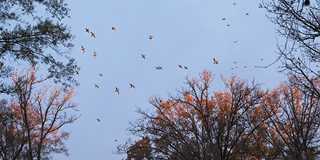
Photo BILLBUCKLEYPHOTOGRAPHY.COM
In the timber, we hold our fire, hold our breath, and fight the urge to look up at a sky turned to feathers and feet. We dont shoot until a third of the ducks are on the water, and with the first thunderous booms of our shotguns, the mallard tornado explodes. Ducks claw at the sky as every square inch of the timber hole seems to be filled with green heads, white breasts, yellow bills, and orange feet.
This is the scene so many duck hunters yearn for: ducks in the timber and ducks in your face. Its an iconic form of waterfowling, which is experienced in perhaps its highest form in the massive, primeval bottomland forests of Arkansas. Thats where I watched those 50 mallards funnel into a timber hole hardly 50 feet across. And its where Ive returned time and again to relive that scenethat feeling of incredulous aweon public lands, on private leases, with guides and outfitters, and with family and friends.
Arkansas is where I want my kids and their kids to stand in water up to their knees and look up at a providential sky full of mallards. But thats not a given. In fact, its getting harder to come by. Thankfully, habitat managers, duck hunters, and other conservationists are doing something about it.
Arkansass storied green-timber duck hunting heritage is at a crossroads. To put it plainly, the human-manipulated flooded forests that have sustained a half century of waterfowlings finest flooded-timber duck hunting are dying. Through a combination of natural and man-made factors, the woods are being flooded earlier, and are holding more water for longer periods of time, than ever before. The result is vast swaths of trees with anemic crowns and leafless branches. Trees that have rotted, weakened root systems and blow over in storms. The slow, inexorable creep of water-tolerant species that offer little food for ducks. And low regenerationin many cases, little to no regenerationof young trees.
For the legendary flooded-timber hunting of Arkansas, the future is as full of challenges as the past has been of gilded green-headed glory. For decades, greentree reservoirsor GTRshave provided waterfowlers with everything they could possibly dream of in a duck hunt: easy access, stunning scenery, close shots, and ducks on top of ducks. Now it might be time for duck hunters and other wetland conservationists to return the favor and work for a future in which these majestic flooded forests can thrive and inspire awe in waterfowlers 50 and 100 years from today.
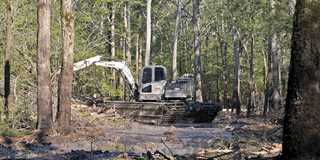
Photo Mike Wintroath, AGFC
It wont be easy, and it wont come quickly. But scientists and land managers across the region known for these unique habitatsArkansas, Missouri, Mississippi, Louisiana, and beyondare already setting their sights on a healthy future for these wetland treasures. Stemming the loss of these flooded forests means making them more resilient to the vagaries of climate change and shifting rainfall patterns. It involves changing how long managers keep GTRs flooded and how they move water through the woods. And it will require a shift in hunters expectations. Already a massive, multiyearno, multi-decadeeffort has commenced to replumb these famous hunting areas. The goal is as simple as achieving it will be complex: ensuring that hunters 50 years from now will have a shot at making flooded-timber memories.
Heres the problem in a nutshell: for millennia, the bottomland forests of the Mississippi Alluvial Valley flooded seasonally with fall and winter rains. Migrating and wintering ducks flocked to the wet woods to feast on acorns. It was a natural system, with enormous variability. Some years there was lots of water. Some years it was dry. Birds moved to where food was available, keying on flooded woods where the water was a foot or less deep, where they could dabble for acorns, seeds, and invertebrates. Red oak species such as Nuttall and willow oaks, whose small acorns fit easily down a mallards gullet, thrived in the woods that flooded during their dormant periods in winter and early spring but dried out during the summer and fall.
Then, in 1926, a farmer named Vern Tindall leveed a 450-acre reservoir in the woods on his farm near Stuttgart, Arkansas. His original idea was to hold irrigation water for farming, but the flooded timber sucked ducks out of the sky. This was likely the first GTR built in Arkansas, but it was hardly the last. The rise of rice planting in Arkansas in the 1930s and 40s saw thousands of acres of bottomlands converted into reservoirs designed to hold water for farming and fowl. Duck numbers were phenomenal, prompting the Arkansas Game and Fish Commission (AGFC) and private landowners to buy up large tracts of bottomland forests. Extensive systems of levees, water-control structures, and connecting ditches plumbed the woods. The timber was flooded in time for opening day of duck season, and the water was held until the last of the hunters packed up their waders months later. These managed impoundments included such soon-to-be-famous hunting areas as Bayou Meto, Wingmead, and Claypools Reservoir. Freelance hunters relished access to publicly owned and managed properties. Guides, lodges, and private duck clubs pumped millions into local economies. Currently, Arkansas alone has some 60,000 acres under greentree management, a world-class treasury of public waterfowl hunting and habitat.
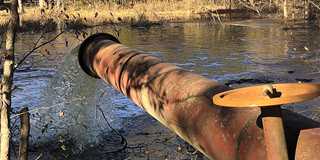
Photo Jody Pagan
The problem is, the trees most beneficial to ducks simply cant tolerate having their feet wet for too long, especially when there are still leaves on those trees. To provide hunting opportunities early in duck season, public land managers have been under pressure to begin flooding GTRs before many trees are dormant. On the other end of the spectrum, says Dr. Scott Manley, director of conservation programs in DUs Southern Region, weve had many years of record rainfall and flooding over the last decade that have extended the winter floods. So theres more and more water for longer periods of time, and the forests just cant handle that.
As a result, Nuttall and willow oaks are dying off and being replaced by more water-tolerant species such as green ash and overcup oak, which dont provide the forage needed by migrating waterfowl. Consider the 65,000-acre Felsenthal National Wildlife Refuge in southeast Arkansas, home of the worlds largest GTR. In 1990, three-quarters of the primary tree species in the flooded Felsenthal woods were in good condition, but that wouldnt last. Refuge managers and researchers with the US Geological Survey conducted a forest health assessment in 2014 that found 40 percent of the willow oak trees had already likely suffered irreversible damage and only 18 percent remained in healthy condition.
Red oaks in most of Arkansass GTRs are showing similar stress. Even in the early years of greentree management, it was obvious that bottomland forests suffered when there was too much water on them at the wrong times of year, says Luke Naylor, waterfowl program coordinator for the AGFC. But having the hard science that our management practices were detrimental to long-term forest health didnt come until 60 years after it was first seen. Changes in these long-lived plant communities can happen right under your nose and you dont really notice. You walk out there and there are oaks, there are trees, but its just not the same.
And its an issue on both public and private lands. One late January afternoon I toured the woods at Five Oaks Duck Lodge with owner George Dunklin Jr., an Arkansas farmer, former AGFC chairman, and past president of Ducks Unlimited. The trees will tell you if what youre doing is right or wrong, he said, as we watched mallards loafing in the flooded woods around the grand lodge. Dunklin has overseen a radical renovation and rethinking of greentree management at Five Oaks over the last decade and advocates for both public and private landowners to look far to the future when making management decisions.
The science has been there for 20 years, but its hard to get people to look long term, he explained. Even here weve made all the mistakes. We wanted to be able to run boats in the woods, so we kept the water too deep. That was good for us, but it wasnt good for the trees and the ducks. Now we have a saying here that guides everything we do. We ask: Whats it going to look like in 100 years? That makes it easier to keep your emotions out of your management.
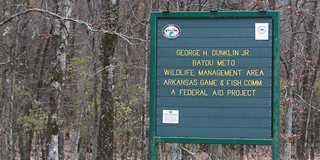
Photo Mike Wintroath, AGFC
At Five Oaks, Dunklin has the ability to put serious resources on the ground, and some of the prescriptions, such as planting containerized red oak seedlings and mulching the forest floor to release nutrients and beneficial vegetation, are pricey. Mother Nature keeps all this, he said. We just have to give her the chance to do what she wants to do naturally. But it takes time and money.
Money is never easy to come by on public lands, but restoring aging GTRs to their former productivity demands additional resources and new ways of thinking. In Arkansas, changing the timing, depth, and frequency of flooding on state-managed hunting areas has already started. Beginning with the 201718 waterfowl season, flooding dates were pushed back, most to November 15, and to December 1 in a few areas in southern Arkansas. In the future, flooding cycles will change, too. In order to more closely mimic natural patterns and boost forest health, the timber will not be purposely flooded at the same depth or for the same length of time year after year. And just like Mother Nature, public land managers will plan for the occasional unmanaged year in which no artificial flooding at all will take place on certain areas.
Meanwhile, a massive renovation of reservoir infrastructure is commencing. Larger pipes and lower levees with more gradual spillways will enable managers to move water more efficiently through the woods. We cant do anything about how much rain falls, Naylor says, but we can make big improvements in how quickly and effectively we get the water off the trees for the spring and summer growing season. A widespread, systematic analysis will help fine-tune solutions to boost red oak regeneration and health. And more education and public outreach will help bring more hunters on board as managers work to turn back time in these ancient bottomland forests.
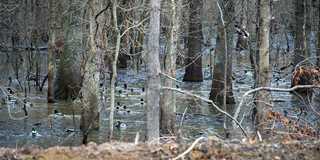
Photo UPCLOSEPHOTO.COM
Whats exciting to see is the widespread commitment to taking care of this precious resource, Manley says. Otherwise, it simply wont be here for future generations to enjoy.
Like any timber hunter whos spent more than a few sunrises with neck craned and eyes to the sky, Ive watched ducks come into the woods in wave after wave. And Ive watched willow oak branches scrape a sky empty of ducks. Slow days, warm days, breathless days, duckless days. Its all been part of the game. But the promise was always there: stick it out, munch on a grain bar, put in the time, and the ducks will come. Perhaps we need a new dawn in the duck woods, with a different kind of faith, one that will ensure that these flooded forests will endure for generations to come.
This will be a journey, Manley says. This will take a decades-long commitment, not just by the folks in Arkansas, but for anyone who cares about these treasured waterfowl habitats and hunting areas.
Which sounds like all of us.
Ducks Unlimited uses cookies to enhance your browsing experience, optimize site functionality, analyze traffic, and deliver personalized advertising through third parties. By continuing to use this site, you agree to our use of cookies. View Privacy Policy